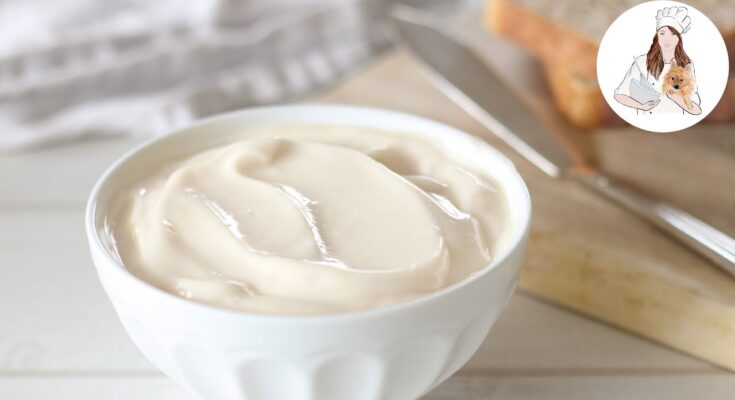Mayo Recipe: Mayonnaise is a versatile condiment found in kitchens worldwide. From sandwiches to salads, it’s an essential ingredient that adds creaminess and flavor to countless dishes.
But have you ever wondered what makes homemade mayo so special? When you make your own mayonnaise, you control the ingredients, ensuring a fresher, healthier, and tastier alternative to store-bought options.
Plus, it’s surprisingly easy to whip up with just a few ingredients and a little patience. Ready to dive into the world of homemade mayo? Let’s get started!
Essential Ingredients for Mayo
To make the perfect mayonnaise, you only need a handful of ingredients:
- Egg yolks – The heart of your mayo, creating a creamy base.
- Oil – Neutral oils like canola or sunflower are ideal, but olive oil adds a robust flavor.
- Acid – Lemon juice or vinegar for tanginess.
- Mustard – Adds depth and helps emulsify.
- Salt and sugar – For seasoning and balance.
Make sure your ingredients are fresh, especially the eggs. For the best flavor, consider using organic or free-range eggs and freshly squeezed lemon juice.
Tools You’ll Need
While making mayo doesn’t require fancy equipment, a few tools can make the process smoother:
- Mixing bowl – A sturdy bowl is essential for whisking or blending.
- Whisk or blender – To emulsify the ingredients.
- Measuring cups/spoons – Precision is key for balancing flavors.
- Spatula – For scraping down the sides.
If you don’t have a whisk, an immersion blender or food processor works wonderfully, especially for beginners.
Step-by-Step Guide to Making Mayo
Step 1: Gather Your Ingredients
Preparation is everything. Start by assembling all your ingredients and tools. Measure them out beforehand to keep the process seamless. Remember, room-temperature eggs emulsify better, so take them out of the fridge at least 30 minutes prior.
Step 2: Start with the Egg Base
Crack one or two egg yolks into your mixing bowl. Whisk them gently until smooth. The eggs act as the binding agent that holds the oil and acid together. If you’re concerned about raw eggs, consider using pasteurized ones for safety.
Step 3: Add Oil Gradually
Here’s where the magic happens. Slowly drizzle oil into the egg yolk while whisking constantly. Adding the oil too quickly can cause the mixture to break, leaving you with a lumpy mess. Begin with a teaspoon at a time until you see the mixture thicken, then gradually increase the flow. Keep whisking until the mayo reaches your desired consistency.
Step 4: Incorporate Flavorings
Now it’s time to bring your mayo to life! Add a teaspoon of mustard, a dash of salt, and a splash of lemon juice or vinegar. Whisk until fully combined, tasting as you go. Want to get creative? Try adding garlic, paprika, or even a touch of honey for unique flavor profiles.
Troubleshooting Common Mayo Problems
Homemade mayo isn’t foolproof, and sometimes things can go awry. Here are some quick fixes:
- Mayo didn’t thicken? Add another egg yolk and whisk vigorously.
- Split mayo? Blend it with a teaspoon of warm water to re-emulsify.
- Overpowering oil flavor? Add a bit more lemon juice or vinegar to balance it out.
Variations of Homemade Mayo
One of the best things about making mayonnaise at home is its versatility. With a few tweaks, you can create delicious variations to suit different dishes and tastes. Here are some popular options:
Garlic Mayo (Aioli)
To make aioli, blend in finely minced garlic or garlic paste with your basic mayo recipe. It’s a perfect complement to seafood, roasted vegetables, or as a dipping sauce for fries.
Spicy Mayo
Add a tablespoon of sriracha, chili paste, or even smoked paprika for a kick of heat. Spicy mayo works wonders on sushi, burgers, and tacos.
Herb-Infused Mayo
Chop fresh herbs like parsley, dill, or cilantro and mix them into your mayo. This version pairs beautifully with grilled meats and salads.
Vegan Mayo
For a plant-based alternative, replace egg yolks with aquafaba (chickpea water). Use the same technique, adding oil gradually, and season with your preferred spices.
How to Store Homemade Mayo
Homemade mayo doesn’t last as long as the store-bought kind because it lacks preservatives. However, with proper storage, you can maximize its freshness.
- Refrigeration: Always store mayo in an airtight container in the fridge.
- Shelf Life: Consume within 5–7 days for optimal freshness.
- Labeling: Mark the container with the preparation date to keep track.
Remember, if your mayo starts to separate or smells off, it’s better to toss it than take risks.
Creative Ways to Use Mayo
Mayonnaise isn’t just a spread—it’s a culinary powerhouse that can enhance a variety of dishes. Here are some creative ways to use it:
As a Spread
Classic but effective, spread mayo on sandwiches, burgers, or wraps for a creamy touch that binds flavors together.
As a Dip
Whip up a dipping sauce by mixing mayo with ketchup, mustard, or hot sauce. It’s perfect for fries, chicken nuggets, and veggie sticks.
As a Dressing
Transform your mayo into a tangy dressing by adding vinegar, sugar, and spices. It’s an excellent base for coleslaw, potato salad, or pasta salad.
As a Marinade
Use mayo as a marinade for meats like chicken or fish. Its rich fat content locks in moisture while enhancing flavor during cooking.
In Baking
Yes, mayo works wonders in baking! Add it to cakes or muffins for extra moisture and a tender crumb. Chocolate mayo cake, anyone?
Health Considerations with Mayo
Mayonnaise gets a bad rap for being high in calories, but when made at home, it can be tailored to fit your dietary needs.
Nutritional Benefits
Homemade mayo contains healthy fats when made with oils like olive or avocado oil. It’s also free from artificial additives and preservatives.
Reducing Calories
Want a lighter version? Reduce the oil and replace part of it with Greek yogurt. You’ll get the same creaminess with fewer calories.
Safe Consumption
If raw eggs make you uneasy, opt for pasteurized eggs or boiled egg yolks to minimize the risk of foodborne illnesses.
Tips for Perfect Mayo Every Time
Crafting flawless mayonnaise takes practice, but these tips can help you master it faster:
- Temperature Control: Ensure all ingredients are at room temperature before starting.
- Patience is Key: Add oil slowly, especially at the beginning, to avoid breaking the emulsion.
- Right Tools: Use a food processor or immersion blender for consistent results.
- Taste and Adjust: Always taste your mayo and tweak the flavors to your liking.
FAQs about Mayo Recipe
1. What Ingredients Do I Need to Make Mayo?
To make mayonnaise, you typically need egg yolks, oil (vegetable or olive oil), vinegar or lemon juice, and a pinch of salt. Some recipes may also include mustard or sugar for additional flavor.
2. Can I Make Mayo Without Raw Eggs?
Yes, you can use pasteurized eggs or even substitute with aquafaba (chickpea water) for a vegan option. These alternatives still give a creamy and thick consistency.
3. How Do I Prevent My Mayo from Breaking?
To avoid a broken mayo (when it separates), ensure you add the oil slowly while blending or whisking. A steady, gradual process helps emulsify the ingredients properly.
4. How Long Does Homemade Mayo Last?
Homemade mayo can be stored in an airtight container in the fridge for up to one week. Always check for any changes in smell or texture before use.
5. Can I Add Flavors to My Mayo?
Absolutely! You can customize your mayo by adding garlic for aioli, herbs for a fresh taste, or chili for a spicy kick. Experiment to find your favorite blend!
Conclusion
Making homemade mayonnaise is a rewarding and straightforward process that elevates your cooking. With just a few ingredients and some practice, you can create a creamy, delicious condiment that’s far superior to store-bought versions. Plus, it’s endlessly customizable, allowing you to experiment with flavors to suit any dish. Whether you’re whipping up a sandwich spread or a cake ingredient, homemade mayo is sure to impress.



